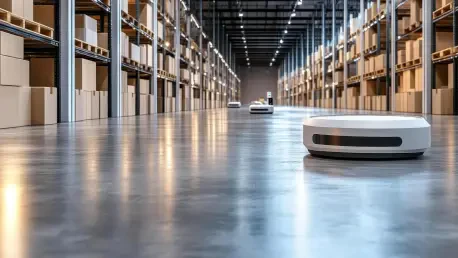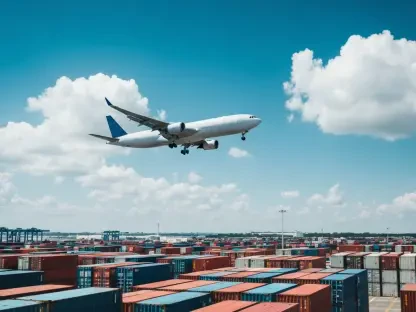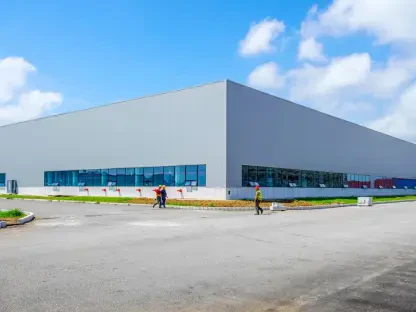In today’s fast-paced world, warehouses grapple with a myriad of challenges, from labor shortages to rising consumer expectations and ongoing supply chain disruptions. Relying solely on manual processes is becoming untenable in such volatile conditions, prompting companies to embrace data-driven solutions that can adapt rapidly to market shifts. Robotics is leading this transformation in warehousing, offering immense advantages in optimizing operations. By automating repetitive, labor-intensive tasks, robots significantly enhance order processing times, streamline inventory control, and alleviate workforce constraints. Modern robotics solutions seamlessly integrate with existing warehouse management systems, unlike their predecessors, which often required rigid setups. This integration allows robots to work alongside human teams, fostering a symbiotic relationship that augments operations in picking, packing, and other logistic activities. As technology evolves, the adoption of warehouse robotics is increasingly becoming a business necessity rather than a luxury, allowing firms to remain agile and cost-effective amidst growing logistical complexities.
Key Technologies in Warehousing
Automated Guided Vehicles and Autonomous Mobile Robots
Automated guided vehicles (AGVs) and autonomous mobile robots (AMRs) are pivotal in transforming the movement of goods across warehouse floors, minimizing the need for human intervention in transport tasks. AGVs navigate predefined routes using magnetic strips or similar signals, making them ideal for environments with structured workflows. AMRs, on the other hand, leverage advanced technologies like LiDAR, computer vision, and simultaneous localization and mapping (SLAM) to dynamically traverse varying routes. These robots adapt swiftly, optimizing paths, circumventing obstacles, and making autonomous decisions. Their versatility makes them perfect for high-performance fulfillment centers that demand adaptability and efficiency. As these technologies advance, their role in ensuring seamless operations and improved throughput becomes critical in warehouses that aim to maintain competitiveness and proficiency in an ever-evolving landscape.
Robotic Picking and Packing Systems
Robotic picking and packing systems utilize innovative components such as robotic arms, computer vision, and deep learning algorithms to adeptly handle goods of assorted sizes and shapes. Such systems markedly enhance the speed and accuracy of order fulfillment, substantially decreasing the likelihood of human error during operations. Integrating predictive analytics enables robotic systems to learn from historical data and fine-tune their grasping techniques. This continuous learning process ensures that performance remains on an upward trajectory, contributing to enhanced efficiency and precision in warehousing tasks. As businesses contend with growing order volumes and complex inventories, adopting sophisticated robotic picking and packing solutions becomes increasingly vital. This further cements their role as essential contributors to the evolution of modern warehouse operations by promoting optimal accuracy, agility, and scalability.
Collaborative Robots and Automated Systems
Collaborative Robots: Cobots
Collaborative robots, or cobots, are engineered to operate safely alongside human workers. They assist in executing physically taxing and repetitive tasks, such as lifting, sorting, and packing, significantly reducing strain on human laborers. Unlike traditional industrial robots, which necessitate restricted workspaces, cobots employ force sensors, motion limitations, and advanced machine learning models to ensure safety in shared environments. These robots enhance efficiency by optimizing workflow patterns and diminishing the risk of injuries stemming from repetitive motions. Cobots serve as indispensable tools in modern warehouses, providing a bridge between human and automated processes. By alleviating manual workloads and improving safety, they facilitate streamlined operations and foster a harmonious working environment, paving the way for enhanced productivity and reduced workplace hazards.
Automated Storage and Retrieval Systems
Automated storage and retrieval systems (AS/RS) play a vital role in optimizing the use of vertical warehouse space through the deployment of shuttles, carousels, or robotic cranes. These setups reduce dependency on manual picking, thereby enhancing inventory accuracy and hastening order processing. AS/RS solutions often incorporate artificial intelligence-driven inventory algorithms that strategically position items for swift retrieval and lower energy consumption. These systems exemplify efficiency and precision, addressing the demands of high-density storage requirements. By automating complex processes and maximizing space utilization, AS/RS facilitate robust inventory management and improve operational throughput. As warehouses strive to meet escalating consumer demands, embracing these automated systems can substantially elevate productivity and aid in overcoming spatial constraints.
Benefits and Challenges in Adoption
Benefits
Robotic automation in warehousing presents a plethora of advantages, with notable improvements in efficiency and productivity. Automated systems for picking, packing, and sorting drastically cut cycle times, resulting in heightened throughput. These robotic solutions uphold superior accuracy and uniformity, mitigating incidents of mispicks and returns. Businesses facing workforce shortages or fluctuating seasonal demands benefit from minimized dependency on temporary staffing and reduced labor expenses. Moreover, robotics enhance workplace safety by assuming labor-intensive tasks, alleviating physical strain and lowering injury risks. Their modular nature allows for easy scalability, enabling companies to expand capacity without disruptive operational changes. These benefits underscore the transformative impact of robotics in a modernized warehousing landscape focused on precision, agility, and growth.
Challenges
Despite the numerous advantages, adopting robotics in warehousing isn’t devoid of challenges. Initial investments can be substantial, encompassing expenses for hardware, software licenses, and potential facility modifications. Integration may pose difficulties, particularly in coordinating data across disparate systems such as warehouse management and enterprise resource planning platforms. Specialized technical expertise is often required to navigate these complexities. Additionally, training employees to proficiently interact with robotic systems is essential but can be challenging if the workforce lacks familiarity with advanced automation technologies. Robotics demand ongoing maintenance, regular updates, and predictive tuning to prevent performance dips or unplanned downtimes. These hurdles necessitate strategic planning and resource allocation to ensure effective adoption and sustained operational excellence.
Steps to Integrate Warehouse Robotics
Conducting Operational Audits and Identifying Bottlenecks
Initiating a robotics strategy requires a thorough evaluation of current operations. Performing operational audits helps decipher inefficiencies within workflows, such as order fulfillment and material handling. By identifying bottlenecks, warehouse managers can determine where automation technologies can deliver the most substantial improvements. Advanced analytics tools can detect congestion patterns, identify recurring errors, and highlight crucial areas that require attention. This strategic assessment strategy ensures a directed and prioritized approach toward robotic integration, streamlining operations, enhancing productivity, and reducing disruptions.
Assessing Pilot Programs and Proof-of-Concepts
Following the identification of problem areas, pilot projects serve as a crucial step in robotics integration. These small-scale implementations enable firms to assess real-world performance, testing how new robotics solutions blend with existing warehouse management or enterprise systems. Evaluating pilot initiatives allows businesses to measure potential returns on investment, discern technical challenges, and mitigate operational disturbances before expanding automation. Deploying these contained pilot programs ensures informed decision-making and fosters a seamless transition to widespread robotics deployment. Such approaches provide valuable insights, maximizing efficiency for large-scale integration and ensuring long-term warehousing success.
Workforce Training and Robotics Solutions
Workforce Training and Change Management
Robotic systems, although highly efficient, require skilled personnel for operation and maintenance, necessitating comprehensive training and change management strategies. Training empowers staff with essential skills, including troubleshooting, system safety protocols, and effective robot management. Cultivating a tech-friendly mindset is crucial in easing the transition to highly automated workflows. Change management programs reduce resistance to new processes, promoting collaboration between manual labor and automated technology. These initiatives ensure harmonious integration, fostering productivity in warehousing operations, and enabling seamless adaptation to evolving technological landscapes.
Selecting Scalable and Interoperable Robotics Solutions
Success in robotics integration is contingent on choosing systems that evolve alongside a company’s needs. Solutions should possess robust API features to engage with logistics software, leverage cloud-based monitoring for remote oversight, and utilize AI-driven decision-making for flexibility. Design considerations must anticipate future upgrades and expansions, ensuring systems can adapt smoothly to changing requirements. Selecting scalable and interoperable robotics empowers businesses to tackle current challenges while readying them for potential innovations and transformations within the logistics sector. Strategically chosen solutions enhance adaptability, fostering long-term growth and enduring competitive advantage in the warehouse environment.
Continuous Optimization and Emerging Trends
Continuous Optimization and AI Enhancements
Robotics implementation in warehousing mandates ongoing optimization to sustain peak performance levels. Employing real-time analytics and predictive maintenance allows firms to refine robotic efficiency, limit downtime, and update capabilities progressively. Advancing machine learning models contribute substantial insights into inventory management, optimizing broader supply chain operations. Continuous monitoring and improvements ensure systems remain agile and effective in handling evolving industry demands. The integration of cutting-edge AI technologies and comprehensive performance evaluation maximizes robotic effectiveness, accommodating transformation within the warehousing domain.
Real-World Impact and Forward-Thinking Trends
The influence of robotics in warehouse environments is prominently observed across sectors like e-commerce, where autonomous mobile robots handle numerous orders and tight deadlines. Retailers and logistics enterprises harness AI-enhanced picking stations to accelerate speed and minimize errors despite vast SKU ranges. Cold-storage facilities benefit from robotic automation, efficiently operating under harsh subzero conditions. Industries such as pharmaceuticals and food processing utilize sterile-compatible robotic arms to adhere to rigorous regulatory standards. Emerging fields like reinforcement learning, swarm robotics, and quantum computing offer promising advancements for further improvements in warehouse operations, underlining the dynamic and transformative nature of robotics within modern logistics.
Looking Ahead
Today’s warehouses face numerous challenges, including labor shortages, high consumer expectations, and supply chain disruptions. Depending solely on manual processes is no longer feasible due to these volatile conditions. To address these issues, businesses are turning to data-driven solutions capable of swiftly adapting to market changes. Robotics stands at the forefront of this evolution, offering significant benefits by optimizing warehouse operations. Robots automate routine, labor-intensive activities, improving order processing speed, inventory management, and easing labor constraints. Unlike earlier models requiring rigid setups, modern robotics seamlessly integrate with current warehouse management systems. This integration fosters a cooperative environment where robots work alongside humans, enhancing tasks like picking and packing. As technology advances, deploying robotics in warehouses is no longer optional but essential, enabling firms to stay nimble and cost-effective amidst complex logistical challenges.









